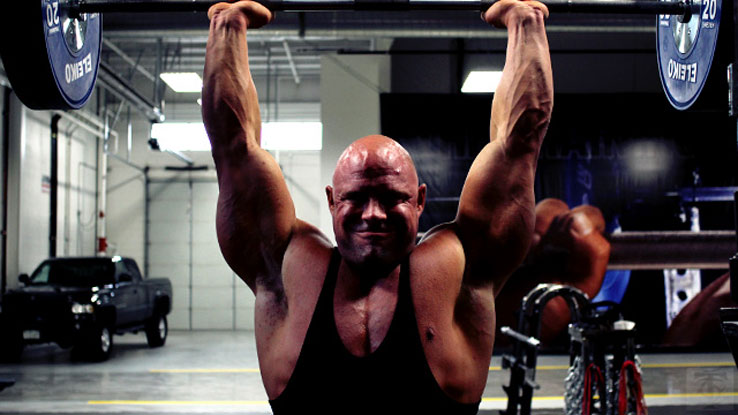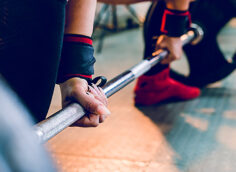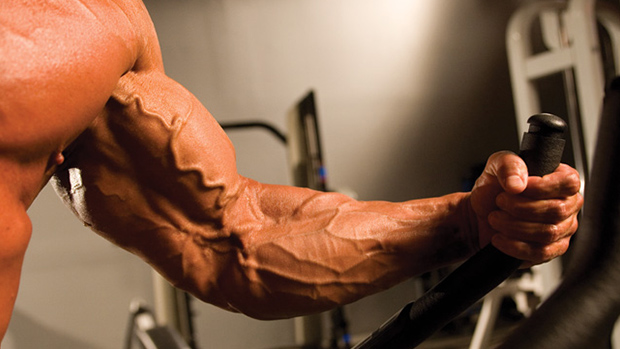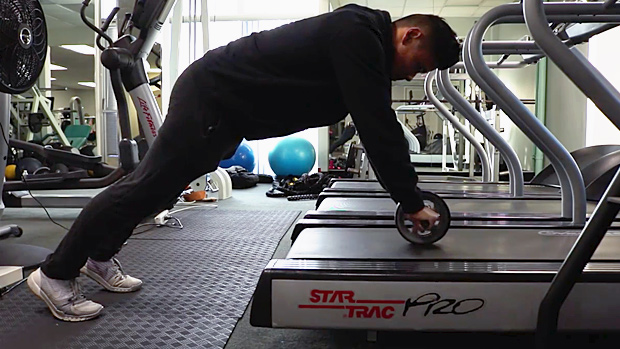Many lifters have shoulder issues that keep them from pressing heavy, or even doing any overhead work. Add to that, not many people are built to press overhead without overarching through their low backs, showing crappy scapular mechanics, or developing some other compensation pattern.
The two main issues that affect the ability to press successfully are stability and structure.
Structurally, some lifters have bones that aren't shaped ideally for overhead work – those with type-3 acromions that hook sharply down and forward. This can cause significant abrasion when abducting and rotating the shoulder.
As for stability, if your body doesn't have the necessary stability to perform a movement in one section, it'll find it somewhere else. For the guy overhead pressing who has to arch the spine significantly, the spine is picking up the load that the shoulder can't handle.
Most rotator cuff injuries come down to a humerus that's too mobile in the glenoid fossa or a scapula that doesn't have the stability to rotate during lifts, and instead winds up either swinging or getting stuck, requiring the rotator cuff to do more and get exposed to more forces.
If the shoulder is unstable, the rotator cuff is responsible for providing a lot of stability; therefore, the answer is to strengthen the rotator cuff with specific exercises. The downside? These exercises focus on creating movement in the shoulder joint rather than stability.
Resistance band exercises provide little benefit to stronger individuals and those who aren't recovering from surgery or acute trauma, as evident by the multitude of people who do them daily and don't see any discernible benefit.
Seriously, if you have a shoulder issue and have been doing the same band exercises forever, shouldn't you have gotten progressively stronger as the issues started to subside?
Performing most rotator cuff-specific exercises that don't require a degree of shoulder stabilization could possibly lead to shoulder injuries. They train the cuff to allow movement instead of preventing it.
If the rotator cuff is designed to provide stability, let's make it provide stability by giving it a load where it has to balance, manage force production from all sides, and control through the range of motion. Also, let's throw some weights on it so it has to fire without producing movement in the joint.
Here are some shoulder-training options that deliver a great stabilization response without making you feel like you're stuck in a rehab clinic. And for you fortunate SOB's that can press pain-free, I'll show you a few cool ways to get stronger overhead.
One way to train the shoulder to become more stable is to reinforce creating a centration effect to keep the humerus solid in the glenoid fossa. This is easily done when the humerus is vertical to the shoulder blade, and the goal is to keep it there.
The cuff has to work all around the shoulder, shear forces are limited, and rather than just repping out for a couple minutes the body has to figure out how to keep the shoulder in position so that it can stay healthy.
One method I love is a supine roll while holding a weight vertically. It's essentially a hip and core driven exercise, but the weight over the shoulder is the major player in this little drama.
The movement is relatively simple: with the arm overhead and the knee bent on that side, use the glute to press the hips to roll over, keeping the core tense so the shoulders roll with the hips. Make sure the arm stays centered and vertical over the shoulder.
You can go surprisingly heavy if using dumbbells, which makes it a great method for those who have shoulder issues and those who are healthy.
Another option to make it more intense is to do a leg swing to go further into the range of motion and build some stabilization at a greater range of motion of the shoulder.
Use a weight that allows you to keep the arm vertical without feeling like it's shaking all over the place. It will be best to use a weight that's challenging to the weaker arm for both sides instead of using two different weights, unless you're involved in a unilateral sport like baseball or golf.
Having the weight in this position and producing a rotation from beneath forces the shoulder to build stability through the transverse plane without increasing the lever arm length or relative load on the shoulder, which are two of the big components involved in injury. They also look completely badass when performed while holding a 100-pound dumbbell.
A good goal to shoot for would be to work up to 40-50% of body weight in the working arm. If you can bench press body weight with both hands, you should be able to stabilize 50% of body weight without moving it around or dropping it on your face.
Finding stability in the overhead position is incredibly important, especially as the weight goes up and shoulder stress increases. Stability, or the ability to produce it through the range of motion, can be a limiting factor not only to injury prevention, but also total weight lifted.
The body will protect and shut down muscles if it feels you're doing something that could damage it, so by having that stability and using it through the full range, you can get bigger lifts, and hopefully get more girls thinking impure thoughts about your hotness.
Overhead stabilization means holding weights overhead while you do other stuff at the same time. It's a simple concept that can make basic movements incredibly hard, like standing up from a kneeling position.
This one doesn't take a lot of weight to be challenging, and most people wind up feeling humbled with only 15-25 pounds per arm. That said, you might feel like you just ran a hard lap on the track by the time you finish a set. The challenge on the shoulder is also there for the core, which makes it doubly awesome.
Another beauty is the Turkish get-up. This is one of the best shoulder mobility and stability exercises I've ever used, and is a great way to point out left and right assymetries.
Clients with fairly pervasive shoulder pain typically have no difficulty going through the movement as long as the weight used is beneath their pain threshold, and they wind up completing the movement without creating new symptoms.
The initial movement is started from the hips, with force transfer from the hips to shoulders, and from there it's up to the arms and core to take the body the rest of the way to the top of the mountain.
The axial loading on the shoulder takes it through saggital, frontal, and transverse planes, making it a great stabilization exercise through a big range of motion without exposing it to negative forces.
Consider overhead pressing sort of like the last girl in the bar – just because you can do them doesn't mean you should, or that there won't be some serious long-term consequences as a result of not taking the steps to be adequately prepared ahead of time.
First we'll work on a limited one-arm overhead press with a half-kneeling stance. This reduces the chance of using the legs to convulse the weight up to the full extended position, and makes cheating the movement by leaning away from the weight or some other postural deviation very difficult – meaning you can only do the movement perfectly.
This also involves a lot more core stabilization than an upright stance, which makes it a great teaching exercise to get the shoulder to stabilize on its own.
Hold the weight so that the elbow is pointing forward instead of out to the side. This helps to provide more space for the humerus and acromion to not become intimately connected. This point will come up again when we get into barbell pressing.
Next is a bottom's-up kettlebell press. This is one of the true banes of my existence, as my left shoulder is about as stable as Lindsay Lohan's parole status. The amazing thing about holding a kettlebell in a bottoms-up position is there's no fooling it – either you have the shoulder stability to do the movement or you don't.
Grip strength when the hand is moved away from your side and overhead tends to decrease, which means your ability to hang on to the handle decreases with a lack of shoulder stabilization. So to press the weight, you have to step it down to a point where you can control it, and you won't be able to bluff or cheat your way through the movement.
From here we can begin to work on overhead variations using a barbell. Since you've worked hard at building the requisite stabilization in the shoulders, you should now be able to confidently press without having your shoulders explode on contact. You still have to consider some common technique issues, though.
The first issue to clean up is the grip. With the bar on your collarbone, your hands should be essentially on top of or slightly inside your shoulders. This helps position your humerus so that you can let it move without beating the heck out of it, and limit the stabilization demand the shoulder has to fight against from a leverage perspective due to having a wider grip.

Gripping the bar with a wider than shoulder width grip can place a lot of additional stress and shear force on the shoulders, so don't do it. Plus it looks dorkier than tucking your t-shirt into your underwear.

Drive the weight up while keeping the elbows pointing forward. To limit shoulder pressure when pressing into the lockout position, focus on keeping the shoulders and neck stacked vertically so that you aren't shrugging or rotating your elbows out. Don't finish with the head pressed forward, as that's a cry for help, not a PR.


Two common versions of the press are the strict military press without any assistance from the legs or hips, and the push press, which uses an initial jump from the legs and hips to begin the movement.
The push press allows for less force on the shoulder when the joint is in an "opened" position and there's less force closure from contracted muscles to stabilize the joint, so I prefer to use this variation where possible. It also doesn't tend to irritate the shoulder as much and it lets you lift significantly more weight.
- Alizadehkaiyat, et al (2011). Shoulder muscle activation and fatigue during a controlled forceful hand grip task. J Electromyogr Kinesiol. 2011 Jun;21(3):478-82
- Kon, et al (2008). The influence of handheld weight on the scapulohumeral rhythm. J Shoulder Elbow Surg 2008 Nov-Dec; 17(6): 943-6
- Omoumi, et al (2011). Glenohumeral Joint Instability. J Magn Reson Imaging. 2011 Jan; 33(1): 2-16
- Riemann, et al (2010). Hand-held dynamometer testing of the internal and external rotator musculature based on selected positions to establish normative data and unilateral ratios. J Shoulder elbow Surg. 2010 Dec; 19(8): 1175-83
- SU, et al (1994). Grip Strength In Different Positions of Elbow and Shoulder. Arch Phys Med Rehabil. 1994 Jul;75(7): 812-815





